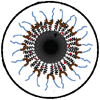Department of Physics and Astronomy: Publications and Other Research

Diandra Leslie-Pelecky Publications
Document Type
Article
Date of this Version
April 1996
Abstract
Self-stabilized magnetic colloids consist of magnetic particles dispersed in an appropriate matrix. Fixing the particles in a stabilizing matrix has the advantage of preventing particle agglomeration, increasing resistance to oxidation, and allowing control over the interparticle spacing and particle size. We describe the chemical synthesis of cobalt nanoparticles in a polystyrene/triphenylphosphine polymer matrix. Depending on the synthesis parameters, magnetic properties of the as-synthesized nanocomposites range from superparamagnetic to ferromagnetic with coercivities on the order of 130 Oe. Solvent choice and polymer crosslinking significantly affect the magnetic properties. Annealing in vacuum produces coercivities of up to 600 Oe and remanence ratios of up to 0.4. Measurement of the isothermal remanence magnetization and dc demagnetization indicate the presence of both magnetizing and demagnetizing interactions, in contrast to particles synthesized without the polymer, which show no evidence for magnetizing interactions. The zero-field-cooled temperature-dependent magnetization displays a cusp, while the field-cooled magnetization increases monotonically below the cusp temperature. Glassy behavior is observed for temperatures below the cusp, although the mechanism producing this behavior is not yet understood.


Comments
Published by American Institute of Physics. J. Applied Physics 79, 5312-5314 (1996). ©1996 American Institute of Physics. Permission to use. http://jap.aip.org/jap/.